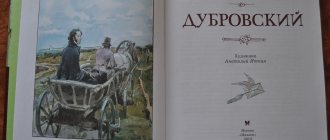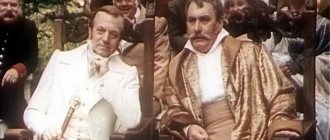The fate of Masha and Vladimir
The romantic love story of Masha and Troekurov is subject to the attacks of fate - they were previously predicted to become spouses, and now their families are united by blood enmity. But true love will always take its toll. Masha is waiting for Vladimir to come for her, she is ready to run away with him. The situation worsens when Masha is wooed by an old man, and her father agrees to their marriage. Masha is not ready to become the wife of an unloved man when she knows that Dubrovsky is nearby. He wants to save her. But due to circumstances, he doesn’t have time.
The priest's verdict has been passed. Masha became the wife of another. Dubrovsky catches up with the wedding carriage and frees Masha. But the choice for her is obvious - between love and an oath, she chooses loyalty to the oath. Masha remains honest before God, destroying possible happiness, because the love of Masha and Dubrovsky is sincere and true happiness awaited them.
Source
Love line in the novel
The love affair of the work is represented by two lines:
- Marya Kirillovna's relationship with Dubrovsky;
- Marya Kirillovna's relationship with Vereisky.
Are you an expert in this subject area? We invite you to become the author of the Directory Working Conditions
The first relationship is largely traditional and literary. They are based on a mysterious romantic story, largely drawn from novels. In the description of the relationship one can feel the influence of “The Young Peasant Lady” and “Blizzard”. Marya Kirillovna herself is presented as
"...an ardent dreamer..."
In Marya Kirillovna’s communication with Dubrovsky, two stages can be roughly distinguished: in the first, Dubrovsky appears as a teacher of the French language, in the second, he acts under his own name.
At the first stage, the peculiarities of the development of interactions between the main characters are determined by social inequality, which will not allow them to be together. The girl's passion was due to the incident with the bear, thanks to which Deforge moves from the category of French teachers to the category of romantic heroes. Dubrovsky’s social skills play a significant role in the formation of a romantic image: he is an excellent dancer, he is organic and natural in provincial social life.
At the second stage, communication between the main characters comes down to three main episodes: Durovsky opens up to Masha, Masha informs him about the matchmaking, dialogue after the wedding on the road to Arbatovo.
Finished works on a similar topic
Course work Pushkin A.S. “Dubrovsky”, brief analysis 490 ₽ Abstract Pushkin A.S. “Dubrovsky”, brief analysis 220 ₽ Test paper Pushkin A.S. “Dubrovsky”, short analysis 220 ₽
Receive completed work or specialist advice on your educational project Find out the cost
In all these cases, Dubrovsky is presented as a night guest, as a ghost, as a dead groom. The author describes the hero's pallor, emphasizing the ghostliness of the character, the impossibility, and dead end of the relationship between him and Masha.
The interaction between the heroine and Vereisky is completely different. Communication with him is interesting and pleasant for Marya Kirillovna. He captivates her with interesting stories and stories. Communication with him is easy, lively, natural, varied and at the same time intellectually rich. The prince is more sophisticated, more refined than everyone with whom the heroine had previously communicated. The day spent at the prince’s estate became a real event for the girl.
As a result of the peculiarities of interaction between characters, the following is reflected:
- the impossibility of a happy marriage, a happy relationship between Marya Kirillovna and Dubrovsky;
- the fact that the marriage between Marya Kirillovna and Vereisky is not so forced as it is predetermined is natural and logical.
The work itself acquires not only social, but also psychological dimensions, reflecting the characteristics of interactions between people.
Essay on Dubrovsky's story of love, grade 6
In the story "Dubrovsky" Pushkin portrays two types of nobles. They are, by and large, the embodiment of good and evil. On the one hand, the writer draws Andrei Gavrilovich Dubrovsky, a noble nobleman. This is the image of an enlightened person. He is educated, smart, honest and noble. According to Pushkin, because this hero is educated, he has the best qualities of mind and heart. We can say with all confidence that this is the best representative of the nobility. Andrei Gavrilovich Dubrovsky was a very proud and honest man. Above all, he valued his good name and noble honor. This hero never humiliated himself before anyone, he always spoke the truth to his face. Dubrovsky held himself on an equal footing with Kirila Petrovich Troekurov, who was much richer and more noble than him. Dubrovsky treated his serfs strictly but fairly. He considered them the same people as the nobles. Next to Dubrovsky, Pushkin depicts Troekurov. He is rich but uneducated. This hero is not worthy of the title of nobleman, so the writer speaks of him as a “Russian gentleman.” Thus, he emphasizes that there were many such Troekurovs in Russia. This hero was arrogant, rude and cruel: “In his home life, Kirila Petrovich showed all the vices of an uneducated person. Spoiled by everything that surrounded him, he was accustomed to giving full rein to all the impulses of his ardent disposition and all the ideas of his rather limited mind.” Kirila Petrovich is uneducated. Hence all his vices. Gluttony, drunkenness, cruelty, tyranny - this is an incomplete list of the qualities of this hero: “Despite the extraordinary strength of his physical abilities, he suffered from gluttony twice a week and was tipsy every evening.” This “old Russian gentleman” was very rich, so he believed that he could mock other people. Kirila Petrovich Troekurov tormented not only his peasants: “16 maids lived in one of the wings of his house, doing handicrafts characteristic of their gender. The windows in the outbuilding were blocked by wooden bars; the doors were locked with locks, the keys to which were kept by Kiril Petrovich. The young hermits, at the appointed hours, went to the garden and walked under the supervision of two old women.” Troekurov cruelly mocked his neighbors and guests. For example, the whole neighborhood knew his fun with the bear. This gentleman scared a new person in his circle with a wild beast. Why does Pushkin portray Dubrovsky Sr. and Troekurov so different? Andrei Gavrilovich Dubrovsky is a positive hero, Kirilla Petrovich Troekurov is a negative one. I think that with the help of these images the writer shows his ideal of a nobleman. He must have nobility, pride, self-esteem. Pushkin admires the fact that in his youth Dubrovsky refused the help of his influential and wealthy friend Troekurov. He did not want to return his fortune in this way, did not want to lose his freedom: “Dubrovsky, in an upset state, was forced to retire and settle in the rest of his village. Kirila Petrovich, having learned about this, offered him his patronage, but Dubrovsky thanked him and remained poor and independent.” And later, when a serious quarrel occurred between him and Kirila Petrovich, the hero put his honest name and human dignity above all else. As a result, Dubrovsky lost everything. But he never regretted his choice. According to Pushkin, a nobleman should be educated and enlightened. Neither power nor money can spoil such a person. But this is only the writer’s ideal. It shows that people like the Dubrovskys are the future of the country. In reality, Pushkin saw the dominance of the Troyekurovs. Narcissistic and despots corrupted by power, who cannot benefit not only Russia, but also their loved ones. For the sake of their whim, their will, such people are ready to break someone else's fate and even life. Troekurov forcibly marries his daughter to an old but very rich prince: “The poor girl fell at his feet and began to sob. “Daddy... daddy...” she said in tears, and her voice died away. Kirila Petrovich hurried to bless her - they lifted her up and almost carried her into the carriage.” Why does Pushkin depict the defeat of Dubrovsky Sr. and the triumph of Troekurov? Andrei Gavrilovich dies, having lost his Kistenevka. Troyekurov receives this village into his possessions. He realizes that in his domains he is god and king, and no one can dictate to him. It seems to me that Pushkin thought that the Troekurovs were invincible, at least for now. There are a great many of them in Russia, they are a huge force. The Dubrovskys are negligible compared to them. But, in spite of everything, the future of Russia, according to the writer, lies only with the enlightened nobles. People like Andrei Gavrilovich Dubrovsky. Thus, by depicting two types of Russian nobility, two landowner families, Pushkin expresses his attitude to the problem of good and evil, to the problem of their existence in contemporary Russia.


